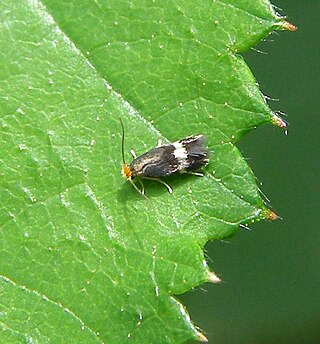
The common white wave is a moth of the family Geometridae. The species was first described by Carl Linnaeus in his 1758 10th edition of Systema Naturae. It is found throughout the Palearctic region. Their habitat is deciduous forests and their surroundings.

Micropterix is a genus of small primitive metallic moths, in the family Micropterigidae within the insect order Lepidoptera. The name was raised by the German entomologist, Jacob Hübner in 1825 and comes from the Greek for mikros, little and pterux, a wing. The moths are distributed across Europe, south to North Africa and east as far as Japan.

Oncocera semirubella, the rosy-striped knot-horn, is a small moth of the family Pyralidae.

Anania hortulata, also known as the small magpie, is a species of moth of the family Crambidae found in Asia, Europe and North America. It was described, in 1758, by the 18th-century Swedish taxonomist, botanist, and zoologist, Carl Linnaeus.

Eriocrania semipurpurella is a moth of the family Eriocraniidae, found from Europe to Japan and in North America. It was first described by James Francis Stephens in 1835. The species closely resembles Eriocrania sangii and the larvae of both species mine the leaves of birch.

Micropterix mansuetella is a species of moth belonging to the family Micropterigidae and can be found in Europe, in very wet woodlands, fens and carrs. The imago was described by Philipp Christoph Zeller in 1844, but the larva and pupa are poorly described.

Micropterix calthella, the marsh marigold moth, is a species of moth belonging to the family Micropterigidae. It is found in damp habitats throughout Europe and is also distributed eastwards to central Siberia. It was first described by Carl Linnaeus in 1761 as Phalaena calthella.

Micropterix aglaella is a species of moth belonging to the family Micropterigidae.It is found in southern France, south-western Switzerland and northern Italy.

Micropterix aruncella is a species of moth belonging to the family Micropterigidae, which is distributed throughout Europe. The imago was first described by Giovanni Antonio Scopoli in 1763. This species is one of the best known members of the family, being found in a wide range of habitats from sea level to over 2,000 metres (6,600 ft); the only habitat not favoured by this species is dense woodland.

Eriocrania sangii, the large birch purple, is a moth of the family Eriocraniidae found in Europe and described by John Henry Wood in 1891. The moth can be found flying in sunshine around birch trees and the larvae feed on birch leaves.

Eriocrania salopiella is a moth of the family Eriocraniidae and is found in Europe. It was described by the English entomologist, Henry Tibbats Stainton in 1854. The larvae mine the leaves of birch.

Eriocrania sparrmannella also known as the mottled purple is a moth of the family Eriocraniidae, found in Europe and Japan. It was first described by the French entomologist, Louis Augustin Guillaume Bosc in 1791. The specific name honours the Swedish naturalist Anders Erikson Sparrman. The larvae mine the leaves of birch.

Eriocrania unimaculella is a moth of the family Eriocraniidae found in Europe. It was first described by the Swedish naturalist Johan Wilhelm Zetterstedt in 1839. The larvae feed inside the leaves of birch, making a mine.

Stigmella plagicolella is a moth of the family Nepticulidae described by Henry Tibbats Stainton in 1854. It is found in all of Europe and the Near East.

Stigmella aurella is a moth of the family Nepticulidae found in Africa, Asia and Europe. It was first described by the Danish zoologist, Johan Christian Fabricius in 1775. The larvae are leaf miners.
Stigmella sorbi is a moth of the family Nepticulidae, described by Henry Tibbats Stainton in 1861. It is found in most of Europe, east to the eastern part of the Palearctic realm.

Schreckensteinia festaliella, the blackberry skeletonizer, is a moth of the family Schreckensteiniidae first described by Jacob Hübner in 1819. It is found in the Palearctic including Europe and has been introduced to North America

Micropterix tunbergella is a moth of the family Micropterigidae found in most of Europe. The moths are very small and can be found feeding on the pollen of hawthorn, oak and sycamore. The larva and pupa are unknown. The moth was described Johan Christian Fabricius in 1787.

Coptotriche marginea is a moth of the family Tischeriidae, found in most of Europe. It was named by the English botanist, carcinologist and entomologist, Adrian Hardy Haworth in 1828, from a specimen found in England. The larvae mine the leaves of brambles (Rubus) species.

Gelechia sororculella, the dark-striped groundling, is a moth of the family Gelechiidae. It is widely distributed from Europe, throughout Siberia to the Russian Far East.



















